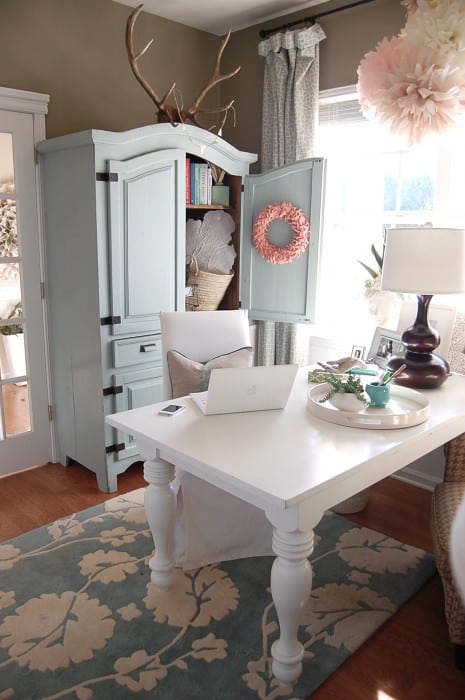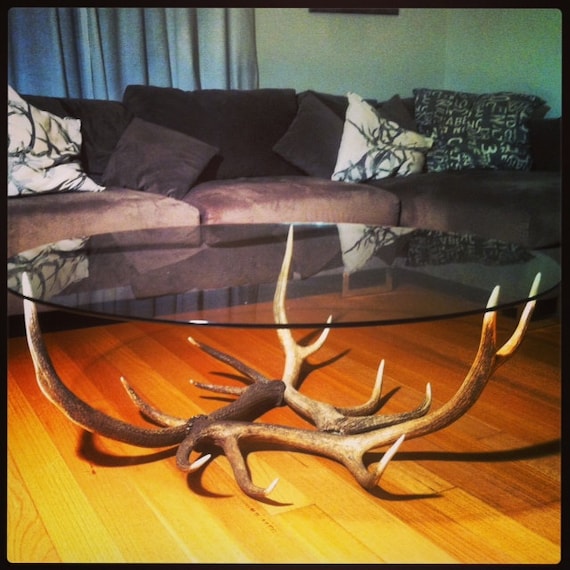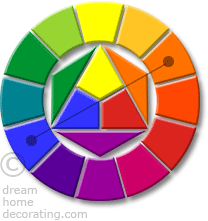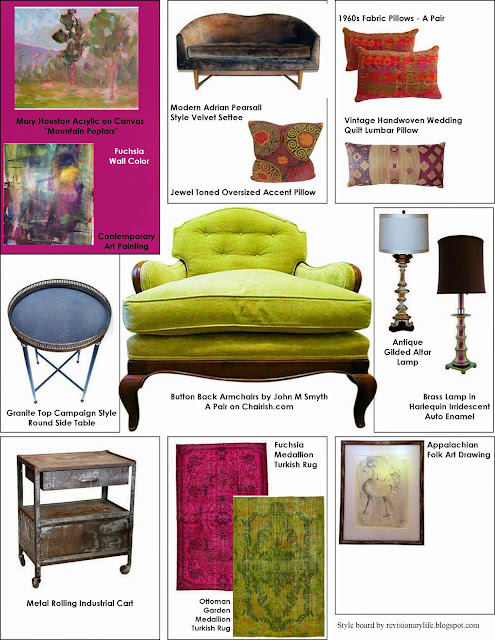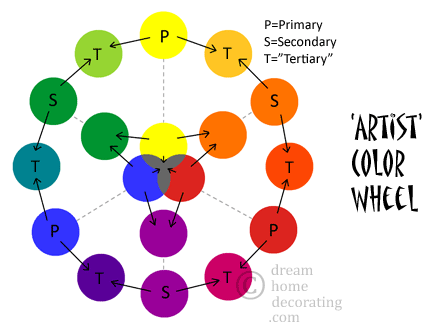Light-value, analogous color used successfully.
Please contact me if you know the source.
While we may LOVE those pure, intense colors, they are rarely colors used in our home decor, and they probably are not really considered our "basic" wardrobe pieces. Why? A few reasons...
Pure, rich, intense color is beautiful...but not restful. It is exciting, inspiring, and we love it! In small doses.
The apartment above uses some intense color, but notice the walls, floors, and even some of the furniture are neutral. The most intense color is the rug under the coffee table. If the entire floor were carpeted, it would be too much! As it is now, the use of color is very successful and dramatic. This is a great example of using complementary color well!
The colors used in this room are red and green. Notice on the color wheel below, red and green are opposite each other on the color wheel, which makes them complementary.
Blue and orange, yellow and violet, red violet and yellow green are all complementary colors, as are others in the color wheel above.
While the red rug in the room above is color wheel red, imagine if the designer had chosen the intense green on the color wheel instead of the soft chartreuse version of green! It would not have been an easy room in which to relax or entertain. The damask velvet upholstery has a brown background, and the coordinating stripe on the chairs has brown, red and soft chartreuse.
In a nutshell, Gestalt is a set of principles arrived at by a group of German psychologists in the 1920’s. They attempted to describe how humans perceive and organize visual elements into groups of "unified wholes" by using a set of principles. Gestalt is about order - it is the opposite of chaos.
We are designed to prefer order, relationship and completion.
Our eyes prefer to see grayed down color and neutrals. Intense, saturated color in large amounts is jarring, and even hard to continue to look at for long periods of time.
Complementary colors - yellow and violet
via Pinterest: Shutterstock Copyright: Copyright MTV Oyj 2010/ Shutterstock.
Complementary Colors and Simultaneous Contrast
Complementary colors, those directly across from each other on the color wheel, are the most visually intense colors to view together.
There is an optical effect called simultaneous contrast that occurs when intense, saturated colors are positioned touching or overlapping each other.
They will appear to "vibrate" or "jump" when we try to look at them for more than a few seconds.
Our eyes and our brains work together to compensate for this physiological effect! If you have intense violet and intense yellow next to each other, and you stare at them for a few minutes, your eyes will actually create a turquoise line between them!
When you KNOW about this visual effect, you can use it to your advantage! Intense opposing color in small amounts can bring just the right "pop" to a composition.
Close-complementary colors - yellow green and red orange
The red-orange flowers against the green-yellow sofa are a nice "pop" of color. Once again, notice the amounts of saturated color in this room - white walls, wood floor, with a patterned rug and bright sofa being "toned down" by dark furniture and art pieces.
The colors above are actually analogous close-complements. This means it is one of the opposite colors, within a close-range of analogous colors.
Analagous colors are colors that are next to each other on the color wheel.
Red
|
Red
Orange
|
Orange
|
Yellow Orange
|
Yellow
|
Yellow
Green
|
Green
|
Blue Green
|
Blue
|
Blue Violet
|
Violet
|
Red
Violet
|
While using complementary colors successfully can be a bit tricky, using analogous colors is relatively fool-proof! Choose any color above, and the colors flanking it within a few hues on either side of it are analogous colors.
Analogous colors - yellow green, green, blue green, blue
Analogous Colors - orange, red orange, red, red violet
Analogous colors - red violet, violet, blue violet, blue, blue green
If you love bright colors, and want to use them in a room or an outfit, choosing a set of analogous colors is about the safest way to use intense color successfully.
Successful use of bright colors!
These handmade felt skulls are a lovely example of using bright colors successfully! Most are secondary and tertiary colors, and there are a few neutrals in some.
If you crave intense color, find a textile you love, and carry a swatch with you. "Match" colors with your swatch. Keep in mind, use complementary colors in small doses for maximum success.
Another way to ensure success is by using close-value colors. Color value is simply how light or dark a color is. Most people do this instinctively - using pastels together, brights together, primary colors together, and deep tones together.
Close value analogous colors
It is possible to mix palettes, but it can be tricky if you don't know the "rules" yet. You're learning the rules NOW!
Review of best ways to use bright color successfully:
- Use primary red, yellow and blue together...with lots of white!
- Use secondary and tertiary colors together as analogous colors.
- Add complementary colors as an accent - a small amount.
Value - the lightness or darkness a color. Hue is also about value. Think about a paint swatch with colors ranging from lighter to darker.
Analogous - next to or beside on the color wheel. It may be 2 - 6 colors, as long as they're positioned nearby and not across.
Complementary - opposite on the color wheel
Close Complement - opposite analogous colors on the color wheel.
Close value - close in the lightness or darkness - such as pastels.
Saturated - intense, pure, color wheel color - not lightened, darkened or mixed with gray.
Word for the Day:
Isaiah 62:1
For Zion's sake I will not keep silent, and for Jerusalem's sake I will not be quiet, until her righteousness goes forth as brightness, and her salvation as a burning torch.



